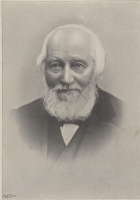










The sailor and hunter Svend Foyn (1809-1894) from Tonsberg was the richest and most famous person in Norway in his day. Today he is all but forgotten. The reason is partly that Foyn invented the grenade harpoon and developed a hunting system that made catching the large fin whales and blue whales feasible.
For the economy and development of the Norwegian economy, Foyn’s life work was of immense importance, but his legacy is today highly controversial. In this first biography of Svend Foyn, Alf R. Jacobsen portrays his adventurous life – first as a sailor and ship captain in the difficult years after the end of the Napoleonic wars, then as a hunter in the Arctic Sea, and finally as a pioneer of hunting methods, successful businessman and nation builder.
Career
The whole process of whaling was changed drastically when Svend Foyn invented the exploding harpoon. By doing so, he removed much of the danger from whaling although it remained a very dangerous undertaking. His invention increased the efficiency by which whales could be captured and made it possible to hunt the larger and faster rorquals, the largest group of baleen whales.
Svend Foyn introduced mechanized, steam-powered catcher boats equipped with bow-chaser deck cannons and heavy-caliber harpoons that exploded on impact. Foyn constructed his 86-ton, seven-knot Spes et Fides, the first steam-powered whale catcher. The ship was equipped with seven whale guns separately mounted on the forecastle, each firing a harpoon and grenade. The vessel was 94 feet (29 m) long, with a 20-horsepower (15-kW) engine. It could reach a speed of 7 knots (13 km/h).
Svend Foyn patented his grenade harpoon gun in 1870. He modified existing designs and utilized ideas developed by Erik Eriksen. It consisted of a cannon that fired a barbed explosive head harpoon. Aimed and fired, the harpoon barb would hook into the whale. A moment later an explosive charge in the head of the harpoon would inflict a mortal wound. Then the whale was retrieved by a winch. Once alongside the whaling vessel, the whale was pumped full of air to keep it afloat, as the whale was moved to the location of processing.
With this development, he launched Norway into a new and profitable industry. After years of perfecting a cannon that could fire a grenade and harpoon simultaneously, Foyn finally managed to catch 30 whales in 1868. These increased efficiency and volume, enabling the harvest not only of all of the species that had been hunted for, but also the largest species which had eluded all previous hunting technologies. The whaling industry was in decline when Foyn first began his development of the bow-mounted harpoon cannon. Foyn's eventual successful development of the cannon, in combination with fast and sleek steam-powered catcher vessels, ushered in a modern whaling industry that was to become dominated first by the Norwegians, then the British and finally the Russians and Japanese.
The Antarctic Expedition of 1894–95 was funded by Svend Foyn and led by Henrik Johan Bull. The expedition was a whaling expedition that sailed to the Ross Sea aboard the ship Antarctic.
Svend Foyn's worker's homes, restored and protected flats for workers built 1857–70. In 1865 there were 73 flats and 303 residents. There was a library, prayer room and the country's first kindergarten. Svend Foyn was not only a man before his time in the modern whaling industry, but also as regards social conditions. Svend and Lena Foyn's Memorial, a home for elderly ladies founded by Lena Foyn in 1896. Since 1983 the building has been used for business purposes. Svend Foyn's Chapel, was consecrated November 5, 1876. There was seating for 500 people and at the time it was Norway's largest and most beautiful chapel.